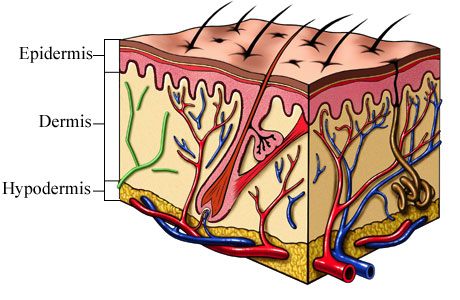Inflammation describes the process by which our body heals itself. Today, I’m going to discuss two different types of inflammation: Acute and Chronic. And I’m going to define the role that inflammation plays in influencing the health of our body’s largest organ, the skin.
When your body is injured, an entire network of inner response “teams” is immediately triggered to help fix the injury, which is why you will notice swelling, tenderness and redness around the injury site. This is the process known as Acute inflammation. Acute inflammation is necessary to help the body heal its injury and protect against infection. The pain response of acute inflammation is your body’s signal to stop what you are doing, to avoid further damage.
Then there is the process known as Chronic inflammation. When constant injury or insult to our body is allowed to occur on a regular basis, our bodies are in an ongoing battle to combat the acute inflammatory process, which then becomes a chronic condition. Chronic inflammation can be triggered by stress, being overweight, sun exposure, diet, exposure to pollution, smoking, hormones and disease, among other things. Over time, excessive chronic inflammation also significantly increases your risk of several life-threatening or degenerative diseases such as arthritis, allergies, asthma, heart disease, diabetes and Alzheimer’s (source: Reinagel, Monica. The Inflammation-Free Diet Plan, 2006. McGraw-Hill).
So what effect does inflammation have on the health of your skin?
We learned the importance of a healthy skin barrier (those outer protective layers of your skin) in my last blog. Having a healthy skin barrier helps protect you from environmental elements that trigger the inflammatory response in the skin. However, if left untreated an ongoing inflammatory response will break down a healthy skin barrier. Chronic inflammation in the skin manifests itself with visible skin aging and skin diseases.
Acute inflammation happens in the form of sunburn when your skin is exposed to excessive sun without any protection (your skin turns red, feels tender and swells slightly). But chronic inflammation actually occurs on a daily basis from sun exposure – even if you are not in the sun long enough to sunburn.
Applying some topical products, like harsh prescriptions or facial scrubs, can trigger inflammation in the skin as well. Microdermabrasion and chemical peels will also trigger an acute response in the skin.
Keep in mind that not all inflammation in the skin is a bad thing. Microdermabrasion or chemical peel treatments help remove the superficial outer layers of stratum corneum (the skin barrier), and help move fresh cells to the skin surface. At the same time, collagen and elastin are stimulated in the dermis, to help plump and support the skin. But you couldn’t microderm or peel your skin every day, or you could be left with one very damaged skin barrier! It’s also important to protect your skin after one of these types of treatments, since leaving your skin unprotected invites harmful exposure to environmental elements (sun, microbes and bacteria).
People who choose to exfoliate on a daily basis (men exfoliate every time they shave their faces) should consider taking steps to repair and fortify their skin barrier after exfoliation, when freshly exposed skin is most vulnerable to damage or bacteria.
Choose skin care products that are fortified with anti-oxidant and anti-inflammatory ingredients that strengthen and protect your skin barrier, to help slow the chronic inflammatory process in the skin. Make it a habit to wear sunscreen every day; preferably a sunscreen that provides at least SPF 30, and is fortified with antioxidants to help fight free radical damage (remember sun exposure is the number ONE element that causes inflammation and visible aging in our skin).
To sum up, some acute inflammation may be helpful to trigger cell turnover and stimulate collagen and elastin, which can help keep our skin looking good – but too much extended and prolonged inflammation creates a damaging chronic process, which contributes to visible skin aging and skin disease.
